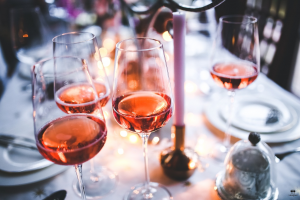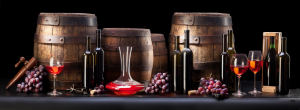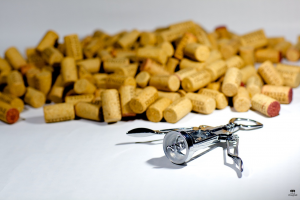CHAMPAGNE IN KAZAKHSTAN
 Champagne in Kazakhstan has long become synonymous with holidays and noisy feasts, without his accompaniment it is difficult to imagine a New Year celebration or a birthday celebration. But not every fan is aware of the fact that champagne is only a kind of sparkling wine, and not every “fizzy” can carry this proud name.
Champagne in Kazakhstan has long become synonymous with holidays and noisy feasts, without his accompaniment it is difficult to imagine a New Year celebration or a birthday celebration. But not every fan is aware of the fact that champagne is only a kind of sparkling wine, and not every “fizzy” can carry this proud name.
Let’s introduce ourselves. Champagne is a sparkling wine that is produced in the French region of Champagne (and only there) by double fermentation of the drink. The French managed to defend their historical primacy in the production of the drink, as well as to secure the right to produce “real champagne”.
HISTORY OF THE CREATION OF CHAMPAGNE OR TAMING OF THE STROPTIC
Some sources assign the discovery of sparkling wine House Pierre Perignon, who lived in the 17th century. Of course, his achievements in the development and popularization of the drink can not be overestimated, but the true pioneers were the servants of the abbey of Saint-Hilaire. Their recipe was not kept secretly and was fairly simple. Effervescence was achieved by additional fermentation of the finished white wine, to which sugar was added, after which the mixture was plugged and left to ferment for the whole winter. It was not always possible to predict the result: some of the bottles exploded ahead of time, others had the acrid taste of yeast. But among the survivors were those who were drunk with their delicate aroma and exquisite taste. Such specimens and conquered the heart of Dom Perignon, who took several decades to “polish” the recipe. The production of champagne concealed many secrets that were discovered only after the master’s death. Among them, the use of bottles with thick glass (English), and a special grape blend, and the “strengthening” of the cork with a rope. This sparkling wine has become a true hallmark of Champagne.
the birthplace of champagne region Champagne
Over the years, this wine has become so popular that everyone wanted to join in its production, and sparkling wine began to be produced all over the world. But in each country it had its own name, since, in the Treaty of Madrid of 1891, the name “champagne” was assigned to the eponymous region of France. In other French regions, champagne splashes are replaced by Cremant sparkling, in Spain they drink Cava, in Germany they use Sekt, and in Italy they drink spumante or prosecco.
DIFFERENCES BETWEEN CHAMPAGNE AND GUNNY WINE
Champagne is synonymous with luxury, well-being and excellent taste. If you want to emphasize the status of your event, give preference to this champagne, rather than his “younger brother” sparkling wines. Although the bottles and foam splashes of these wines are similar, the differences between them are still significant.
Differences between champagne and sparkling wine
Composition. For the production of champagne using only the following grapes: Pinot Noir, Pinot Minier and white Chardonnay. While, for the manufacture of sparkling wine can be used combinations of different varieties.
Motherland The original is produced in the French region of Champagne.
Motherland The original is produced in the French region of Champagne.
Method. In production, only the classical method is used. The process of producing sparkling wines is not so categorical. Apply: classic, Sharma, or even carbonated.
TYPES OF CHAMPAGNE
As for still wines, sparkling (and champagne is no exception) has its own classification: by sugar content, by color, by brand / non-brand.
By sweets: doux (sweet), demi-sec (semi-dry), sec (dry), extra sec (extra-dry), brut (almost completely dry), extra brut (without added sugar).
Types of champagne
The color scheme divides the wine into red, pink and white.
If there is no “vintage” mark on the bottles, then this is non-marking. It is made from a mixture of grape berries from different years. Whereas vintage – wines from berries of one year.
BOTTLE CHAMPAGNE AND RULES OF FEEDING
Of course, a standard bottle (750 ml) is more familiar to our eyes, but the options for champagne tanks do not end there. The next most popular are 1.5 l of “magnum” and 3 l of “jerovoam”, and about a dozen more of various forms and volumes, the largest of which is 30 l of “melchizedek”.
Bottle of champagne and filing rules
Champagne is a very delicate drink, and the wrong temperature (high) can adversely affect the level of “effervescence”. The drink must be cooled to a temperature of 6-8 ° C. But not in the freezer, the best bucket with ice and water. Remember that supercooled champagne is completely deprived of taste and aroma, so do not try to freeze it. Champagne – the best aperitif, before the main meal. However, if you still want to combine champagne with food, then you need to remember the basic principle – dry to sour and salty dishes, sweet to desserts and fruits.
POPULAR CHAMPAGNE IN KAZAKHSTAN
Our compatriots with pleasure include champagne in their festive menus. The most popular types of champagne in Kazakhstan are:




